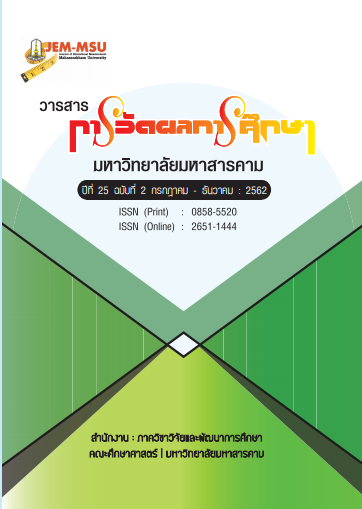The Effectiveness and Retention of Chinese Sentence Learning for Communication, Using Songs and Traditional Teaching Method
Main Article Content
Abstract
The research entitled The Effectiveness and Retention of Chinese Sentence Learning for Communication, Using Songs and Traditional Teaching Method had the objectives to: 1) compare the effectiveness of Chinese sentence learning for communication between the group taught by using songs as a medium of instruction and the group taught by the traditional teaching method; 2) study the retention of the Chinese sentence learning for communication as the effects of teaching by using songs and traditional teaching method. The sample consisted of 77 students from all class years who enrolled in the Chinese Conversation for Daily Life course in the second semester of the academic year 2018 of Rajamangala University of Technology Isan Surin Campus. The 77 students were divided into two groups: 39 students learned by using songs as a medium of instruction and the other 38 students learned by using the traditional teaching method. The research tools consisted of 1) 12 plans of organizing for learning using songs as a medium of instruction; 2) 12 plans of organizing for learning using the traditional teaching method. The allotted time was 2 hours a week, 24 hours totally; 3) a learning achievement test. The duration of the research was 15 weeks. The statistics used in this research were the mean, standard deviation and t-test (independent samples).
The results were as follows:
1) The comparison of the effectiveness of the Chinese sentence learning for communication between the group taught by using songs as a medium of instruction and the group taught by the traditional teaching method revealed that using songs as a medium of instruction and the traditional teaching method made no difference on the Chinese sentence learning for communication.
2) The study on retention of the Chinese sentence learning for communication as the effects of teaching by using songs and traditional teaching method revealed that using songs as a medium of instruction and the traditional teaching method enabled the students to retain Chinese sentence learning for communication.
Article Details
The content and information contained in the published article in the Journal of Educational Measurement Mahasarakham University represent the opinions and responsibilities of the authors directly. The editorial board of the journal is not necessarily in agreement with or responsible for any of the content.
The articles, data, content, images, etc. that have been published in the Journal of Educational Measurement Mahasarakham University are copyrighted by the journal. If any individual or organization wishes to reproduce or perform any actions involving the entirety or any part of the content, they must obtain written permission from the Journal of Educational Measurement Mahasarakham University.
References
กมลรัตน์ หล้าสุวงษ์. (2528). จิตวิทยาการศึกษาฉบับปรับปรุงใหม่. พิมพ์ครั้งที่ 3. กรุงเทพฯ: ภาควิชาการแนะแนวและจิตวิทยาการศึกษา คณะศึกษาศาสตร์ มหาวิทยาลัยศรีนครินทร์วิโรฒ ประสานมิตร.
ชลธิชา ทิพย์ดวงตา, ศักดา สวาทะนันทน์, นงลักษณ์ เขียนงาม และ พรสวรรค์ เพ่งพิศ. (2561). ผลการใช้ เพลงภาษาฝรั่งเศส เพื่อพัฒนาทักษะการเขียนประโยคความเดียวของนักเรียนชั้นมัธยมศึกษาปีที่ 5 โรงเรียนวัฒโนทัยพายัพ จังหวัดเชียงใหม่. วารสารมนุษยศาสตร์ สังคมศาสตร์ และศิลปะ, 11(1): 42 - 56.
ชัยวัฒน์ สุทธิรัตน์. (2559). 80 นวัตกรรมการจัดการเรียนรู้ที่เน้นผู้เรียนเป็นสำคัญ. พิมพ์ครั้งที่ 7. นนทบุรี: พีบาลานซ์ดีไซน์แอนปริ้นติ้ง.
ชูศรี วงศ์รัตนะ. (2560). เทคนิคการใช้สถิติเพื่อการวิจัย. พิมพ์ครั้งที่ 13. กรุงเทพฯ: อมรการพิมพ์.
ญาศินี อัศเวศน์. (2554). ความรู้พื้นฐานเกี่ยวกับการจัดการ. ปทุมธานี: มหาวิทยาลัยเทคโนโลยีราชมงคล ธัญบุรี.
เนาวรัตน์ อินทรประสิทธิ์ และอาคม สระบัว. (2558). การใช้กิจกรรมเพลงภาษาอังกฤษ เพื่อส่งเสริมการออกเสียงต่อเนื่องกันในภาษาอังกฤษ. มหาวิทยาลัยราชมงคลสุวรรณภูมิ ศูนย์พระนครศรีอยุธยาหันตรา.
บุญชม ศรีสะอาด. (2542). วิธีการสถิติสำหรับการวิจัย. พิมพ์ครั้งที่ 2. กรุงเทพฯ: สุวีริยาสาสน์.
พิชิต ฤทธิ์จรูญ. (2545). หลักการวัดและประเมินผลการศึกษา. พิมพ์ครั้งที่ 2. กรุงเทพฯ: เฮ้าส์ ออฟ เคอร์มีสท์.
ไพลิน แก้วดก และทัศน์ศิรินทร์ สว่างบุญ. (2562). การศึกษาผลสัมฤทธิ์ทางการเรียนและความคิดสร้างสรรค์ ทางวิทยาศาสตร์ ของนักเรียนชั้นมัธยมศึกษาปีที่ 4 โดยการใช้การสอนแบบสร้างสรรค์เป็นฐาน: การวิจัยผสานวิธี. วารสารการวัดผลการศึกษา มหาวิทยาลัยมหาสารคาม, 25(1): 206 - 224.
รุจิร์ ภู่สาระ. (2555). การเขียนแผนการเรียนรู้. กรุงเทพฯ: บุ๊ค พอยท์.
วันวิสา กองเสน. (2558). การศึกษาผลสัมฤทธิ์ทางการเรียน ความคงทนในการเรียนรู้ และเจตคติต่อการเรียนวิชาชีววิทยา เรื่องอาณาจักรของสิ่งมีชีวิต ด้วยการจัดการเรียนรู้แบบวัฏจักรสืบเสาะหาความรู้ 7 ขั้นร่วมกับเทคนิคการใช้ผังความคิดของนักเรียนชั้นมัธยมศึกษาปีที่ 6. วิทยานิพนธ์วิทยาศาสตรมหาบัณฑิต, มหาวิทยาลัยบูรพา.
สำนักงานเลขาธิการสภาการศึกษา. (2560). แผนการศึกษาแห่งชาติ พศ. 2560 - 2579. กรุงเทพฯ: กระทรวงศึกษาธิการ.
สิรินธร สินจินดาวงศ์. (2547). วิธีการวิเคราะห์ข้อสอบ. วารสารวิจัยศรีปทุมปริทัศน์, 4(1): 21 - 33.
สุภัชญา สวัสดิ์โยธิน. (2557). ปัญหาการเรียนการสอนวิชาการสนทนาภาษาจีนในชีวิตประจำวัน มหาวิทยาลัยเทคโนโลยีราชมงคลอีสาน วิทยาเขตสุรินทร์. วารสารวิจัยมหาวิทยาลัยราชภัฏสุรินทร์, 2(4): 73 - 81.
อัศรภูมิ จารุภากร และ พรพิไล เลิศวิชา. (2550). สมอง เรียนรู้. กรุงเทพฯ: ศิริวัฒนาอินเตอร์พรินท์.
Aguirre, Diego ; Bustinza, Daisyi and Garvich, Mijail. (2016). Influence of Songs in Primary School Students Motivation for Learning English in Lima, Peru. English Language Teaching, V9, p2.
Atkinson, R. C., & Shiffrin, R. M. (1968). Human memory: A proposed system and its control processes. Cited from K. W., & Spence, J. T. The psychology of learning and motivation (Volume 2). New York: Academic Press.
Baddeley, A.D. (2012). Working memory: theories, model, and controversies. Annual Review of Psychology, 63 (1), 1 - 29.
Chen, Ai-Hwa. (2016). Perspectives upon Integrating Music into Freshman English Pronunciation Training Classroom. Asian Journal of Education and Training, V2, p1.
Matlin. M. W. (1995). Psychology. 2nd ed.: Holt Rinehart and Winston, Inc.
Ramburuth, P and Daniel, S. (2011). Integrating Experiential Learning and cases in International Business. Journal of Teaching in International Business, 22(1), 38 - 50.
Yamane Taro. (1967). Statistics, An Introductory Analysis. 2nd ed. New York: Harper and Row.
Yee Pinn Tsin and Isabel. (2015). Composing Songs for Teaching Science to College Students. Universal Journal of Educational Research, V3, p10.
Yu Yue. (2012). A study of English Learning Motivation of Less Successful Student. Journal of Contemporary English Teaching and Learning in Non - English Speaking Countries, 1(2), 1 - 20.


